Table of Contents
- 1 What is Indifference Curve?
- 2 Definition of Indifference Curve
-
3 Characteristics of Indifference Curve
- 3.1 All Combinations on an Indifference Curve gives Same Level of Satisfaction
- 3.2 A Higher Indifference Curve Shows Higher Level of Satisfaction
- 3.3 An Indifference Curve Slopes Downward to the Right
- 3.4 An Indifference Curve Is Convex to the Point of Origin
- 3.5 Two Indifference Curves Do Not Intersect Each Other
- 3.6 An Indifference Curve Neither Touches Horizontal Axis Nor Vertical Axis
- 3.7 Indifference Curves Are Not Necessarily Parallel to Each Other
- 4 Indifference Curve Approach
-
5 Properties of Indifference Curve
- 5.1 Indifference Curve Slopes Downward From Left to Right, or an Indifference Curve Has a Negative Slope
- 5.2 Indifference Curve is Convex to the Point of Origin
- 5.3 Two Indifference Curves Never Cut Each Other
- 5.4 Higher Indifference Curves Represent More Satisfaction
- 5.5 Indifference Curve Touches Neither X-axis Nor Y-axis
- 5.6 Indifference Curves Need Not Be Parallel to Each Other
- 5.7 Indifference Curves Become Complex in Case of More Than Two Commodities
What is Indifference Curve?
A curve showing different combinations of two commodities giving the same level of satisfaction to the consumer is called the indifference curve. A consumer is indifferent to these various combinations because the level of satisfaction is the same. On account of the indifference or neutrality of an individual consumer, these curves are also called indifference curves.
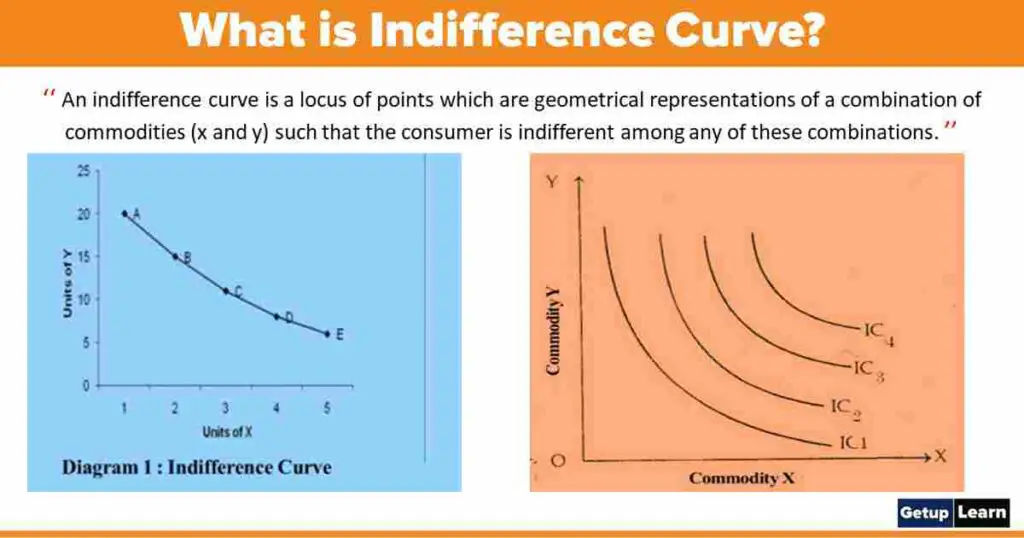
Table of Contents
Definition of Indifference Curve
[su_quote cite=”AuthProf. Henderson and Prof. Quandt”]The locus of all commodity combinations from which a consumer derives the same level of satisfaction forms an indifference curve.[/su_quote]
[su_quote cite=”Prof. A.L. Mayers”]An indifference schedule may be defined as a schedule of various combinations of goods that will be equally satisfactory to. the individual concerned. If we depict this in the form of a curve, we get an indifference curve.[/su_quote]
[su_quote cite=”AuthEdgeworth”]Indifference curve is that path on which a substitution on a particular commodity by another in any manner or quantity gives the consumer the same satisfaction in any position.[/su_quote]
[su_quote cite=”Prof. J.M. Joshi”]An indifference curve is a locus of points which are geometrical representations of a combination of commodities (x and y) such that the consumer is indifferent among any of these combinations.[/su_quote]
[su_quote cite=”Prof. J.K. Smith”]It is the locus of the points representing pairs of quantities between which the individual is indifferent, so it is termed as indifference curve.[/su_quote]
Characteristics of Indifference Curve
The following are characteristics of indifference curve:
- All Combinations on an Indifference Curve gives Same Level of Satisfaction
- Higher Indifference Curve Shows Higher Level of Satisfaction
- An Indifference Curve Slopes Downward to the Right
- An Indifference Curve Is Convex to the Point of Origin
- Two Indifference Curves Do Not Intersect Each Other
- An Indifference Curve Neither Touches Horizontal Axis Nor Vertical Axis
- Indifference Curves Are Not Necessarily Parallel to Each Other
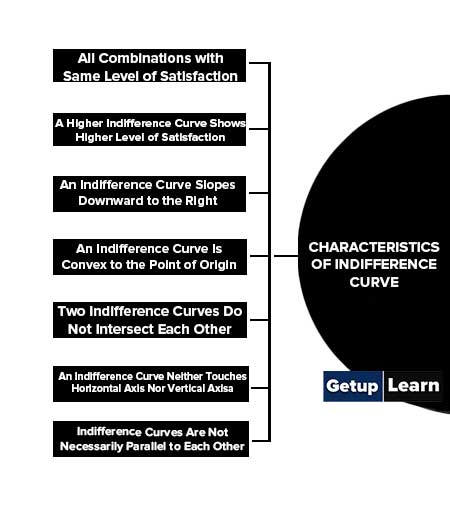
All Combinations on an Indifference Curve gives Same Level of Satisfaction
As defined then indifference curve gives the same level of satisfaction at different points or combinations of two commodities. A, B, C, D & E combinations, in the diagram clarifies this characteristic of an indifference curve.
A Higher Indifference Curve Shows Higher Level of Satisfaction
Another characteristic of the indifference curve is that the higher the indifference curve higher will be the level of satisfaction. It has been shown in the diagram where IC1, IC2 lC3 and IC4 four indifference curves show different levels of satisfaction. From the point of level of satisfaction they can be put in this order of preference like 1C4>IC3>IC2>IC1 respectively.
An Indifference Curve Slopes Downward to the Right
Indifference curves slope downward to the right because the consumer has to reduce the consumption of one commodity (y) if he increases the consumption of commodity-x. In order to maintain the same level of satisfaction, he has to increase the consumption of commodity x with the decrease in the consumption of commodity y. It can be seen from the diagram.
An Indifference Curve Is Convex to the Point of Origin
An indifference curve is convex to the origin because of the application of the principle of diminishing marginal rate of substitution. In order to get the same level of satisfaction, an individual consumer has to consume more of X commodity and he has to sacrifice more of y-commodity.
MRS is the rate of change in one commodity-y in relation to one unit change in commodity-X. The rate of change is decreasing. The MRSxy is decreasing due to the operation of the principle of diminishing marginal rate of substitution as shown in the diagram.
Two Indifference Curves Do Not Intersect Each Other
Another characteristic of indifference curves is that two indifference curves never intersect each other as they represent different levels of satisfaction. Following indifference curves show the situation In the diagram two indifference curves IC and IC1 have been shown. Before E point IC shows a higher level of satisfaction. While E-point IC1 shows a higher level of satisfaction. It is not possible. Hence we can say that two indifference curves never intersect each other because they show different levels of satisfaction.
An Indifference Curve Neither Touches Horizontal Axis Nor Vertical Axis
Another characteristic of indifference curves is that an indifference curve does not touch the ox-axis, if it does so it means the consumer consumes a very large amount of commodity – X and zero amount of commodity – Y. If the indifference curve touches the vertical line (y-axis) then he will consume a very large quantity of commodity Y while zero quantity of commodity – X. This situation has been shown in the diagram given below:
The IC touches oy-axis while IC1 touches ox-axis where he consumes a very large amount of Y and zero of X while incase of IC1, he has a large amount of X commodity while zero amount of Y commodity. But such trends are against the definition of an indifference curve. i.e. combination of two commodities.
Indifference Curves Are Not Necessarily Parallel to Each Other
As we know that all indifference curves slope downward to right or they have negative slopes. But the rate of slope may not necessarily be the same as shown in the following diagram:
Indifference Curve Approach
The modern theory of consumer behaviour is based on the ordinal approach to the utility which tells that utility is not measurable in numerical numbers but can be put in order of preference like I, II and III based on ordinal numbers. It is also known as the indifference curve approach. Consumer behaviour is studied on the basis of the indifference curve approach because it has removed the weaknesses of the cardinal approach based on utility analysis.
Assumptions of Indifference Curve Approach
Modern utility theory of consumer behaviour is based on an ordinal approach. The theory is based on the following assumptions:
- Maximisation of Satisfaction
- Ordinal Measurement of Satisfaction
- Budget Constraint
- Diminishing Marginal Rate of Substitution
- Scale of Preferences
- Rational Consumer
- Diminishing Marginal Rate of Substitution
- Ordinal Utility
- Independent Scale of Preference
- Non Satiety
- Consistency in Selection
- Transitivity
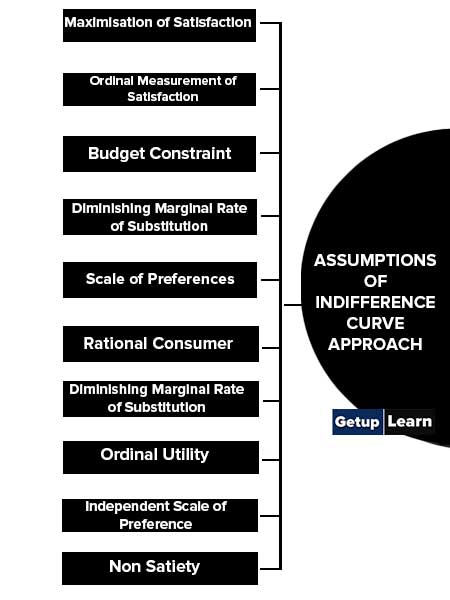
Maximisation of Satisfaction
The theory is based on the assumption of the maximisation of satisfaction by each individual consumer within his given income and market prices. He has perfect knowledge of market conditions regarding the availability of goods and their prices.
Ordinal Measurement of Satisfaction
The approach assumes that satisfaction is measured in ordinal numbers like I, II and III in place of cardinal numbers like 1, 2 and 3.
Budget Constraint
The money income or budget of each consumer is given which is spent on purchasing various goods and services to satisfy his wants. He tries to maximize his satisfaction with his given income or budget constraint.
Diminishing Marginal Rate of Substitution
The approach assumes that there is a diminishing marginal rate of substitution (MRSxy ). It means when a consumer consumes X and Y commodities. The MRSXY is the rate of change in one commodity (y) in relation to one unit change in the other commodity (x). On account of it, the indifference curve shows a diminishing marginal rate of substitution of x for y (MRSxy ).
Scale of Preferences
The consumer has a scale of preferences under the indifference curve approach or analysis. He has order of preferences namely X, Y and Z goods. It means he prefers x first (I), y second (II), and z third (III). He ranks in order of preferences like X>Y>Z. It means there is consistency in preferences.
Rational Consumer
It is assumed that the consumer will behave rationally. It means the consumer would like to get maximum satisfaction out of his total income.
Diminishing Marginal Rate of Substitution
It means as the stock of a commodity increases with the consumer, he substitutes it for the other commodity at a diminishing rate.
Ordinal Utility
A consumer can determine his preferences on the basis of satisfaction derived from different goods or their combinations. The utility can be expressed in terms of ordinal numbers, i.e., first, second etc.
Independent Scale of Preference
It means if the income of the consumer changes or prices of goods falls or rise in the market, these changes will have no effect on the scale of preference of the consumer. It is further assumed that scale of preference of a consumer is not influenced by the scale of preference of another consumer.
Non Satiety
A consumer does not possess any good in more than the required quantity. He does not reach the level of satiety. Consumer prefers more quantity of a good to less quantity.
Consistency in Selection
There is consistency in consumer’s behaviour. It means that if at any given time a consumer prefers A combination of goods to B combination, then at another time he will not prefer B combination to A combination. A>B = B|>A It means if A is greater than (>) B, B cannot be greater than (>) A.
Transitivity
It means if a consumer prefers A combination to B combination, and B Combination to C Combination, he will definitely prefer A combination to C combination. Likewise; if a consumer is indifferent towards A and B and he is also indifferent towards Band C, then he will also be indifferent towards A and C.
Properties of Indifference Curve
These are properties of indifference curve understand in detail:
- Indifference Curve Slopes Downward From Left to Right, or an Indifference Curve Has a Negative Slope
- Indifference Curve is Convex to the Point of Origin
- Two Indifference Curves Never Cut Each Other
- Higher Indifference Curves Represent More Satisfaction
- Indifference Curve Touches Neither X-axis Nor Y-axis
- Indifference Curves Need Not Be Parallel to Each Other
- Indifference Curves Become Complex in Case of More Than Two Commodities
Indifference Curve Slopes Downward From Left to Right, or an Indifference Curve Has a Negative Slope
The downward slope of an indifference curve indicates that a consumer will have to curtail the consumption of one commodity if he wants to consume a large quantity of another commodity to maintain the same level of satisfaction. If an indifference curve does not slope downwards it can either be a vertical line or horizontal line or an upward sloping curve.
Consider the following shapes of an indifference curve. In the diagram quantity of apples is shown on the ox-axis and the quantity of oranges on the oy-axis. Let us suppose, an indifference curve is a vertical line MB. Combination A on this curve represents more units of oranges with the same units of apples as compared with combination C.
Consequently, A combination yields more satisfaction than C combination. So an indifference curve cannot be vertical or parallel to the oy-axis. If the indifference curve is a horizontal line then the H combination will yield more satisfaction than the C combination because in the H combination there are more units of apples than in the C combination Consequently, an indifference curve cannot be a horizontal line or parallel to the x-axis.
If the indifference curve is upward sloping like IJ, the consumer will get more satisfaction from combination A than B and C. Consequently, an indifference curve cannot be upward sloping. If the indifference curve is downward sloping, the consumer will get equal Satisfaction from A as well as B combinations.
Because in the case of combination A if the quantity of oranges is more than in combination B, then the quantity of apples is less than in combination B. Consequently, the slope of the indifference curve will be downward sloping.
Indifference Curve is Convex to the Point of Origin
An indifference curve will ordinarily be convex to the point of origin. This property is based on the law of diminishing marginal rate of substitution. If indifference is not convex to the point of origin 0, it can either be a straight line or concave. But it can be proved with the help of the diagram that on the basis of the assumption of the law of diminishing marginal rate of substitution both these situations are not possible.
In the first indifference curve is a downward-sloping straight line. It signifies that the marginal rate of substitution of apples for oranges remains constant, as shown by AB = CD = EF. Such an indifference curve can be possible only in case of perfect substitutes.
If the indifference curve is concave to the point of origin, it signifies that the marginal rate of substitution of apples for oranges is increasing. It would mean that as the quantity of apples is increasing, its importance is also increasing, which it does not happen in real life.
If the indifference curve is convex to the point of origin 0, it signifies that the marginal rate of substitution of apples for oranges is diminishing. It means as the consumer gets more and more apples he parts with less and fewer units of oranges. This situation conforms to real life. Consequently, the indifference curve is convex to the point of origin.
Two Indifference Curves Never Cut Each Other
Each indifference curve represents different levels of satisfaction, so their intersection is ruled out. In this diagram two indifference curves IC1 and IC2 have been shown intersecting each other at point A, but it is not possible points A and C on indifference curve IC1 represent combinations yielding equal satisfaction, that is, A = C Likewise points A and B on indifference curve IC2 represent combinations yielding equal satisfaction, that is, A = B.
It implies that satisfaction from B combinations is equal to satisfaction from C combination, but it is not possible because in B combination quantity of oranges is more than in C combination, although the quantity of apples in both combinations is equal.
Higher Indifference Curves Represent More Satisfaction
In this diagram, IC2 is higher than IC1. Point B on IC2 represents more units of apples and oranges than point A on the IC1 curve. Hence point B on IC2 will give more satisfaction than point A on IC1. It is evident, therefore, that the higher the indifference curve, the greater the satisfaction it represents.
Indifference Curve Touches Neither X-axis Nor Y-axis
In case an indifference curve touches either axis it means that the consumer wants only one commodity and his demand for the second commodity is zero. An indifference curve may touch the oy-axis if it represents money instead of a commodity. In this diagram, IC touches the oy-axis at point M.
It means the consumer has in his possession OM quantity of money and does not want any unit of apples. At a point, N consumer likes to have a combination of OQ units of apples and OP units of money. This combination will yield him the same satisfaction as by keeping OM units of money.
Indifference Curves Need Not Be Parallel to Each Other
Indifference curves mayor may not be parallel to each other. It all depends on the marginal rate of substitution on two curves shown in the indifference map. If the marginal rate of substitution of different points on two curves diminishes at a constant rate, then these curves will be parallel to each other, otherwise, they will not be parallel.
Indifference Curves Become Complex in Case of More Than Two Commodities
When a consumer desires to have combinations of more than two commodities, say, three commodities, we will have to draw three-dimensional indifference curves which are quite complex. If the consumer wants a combination comprising of more than three goods, such a combination cannot be expressed in the form of a diagram. In that case, we will have to take the help of algebra.



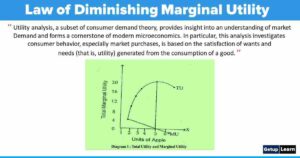








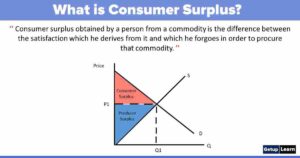


Thank for clarifying the concepts.